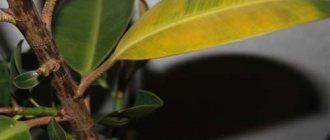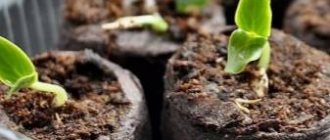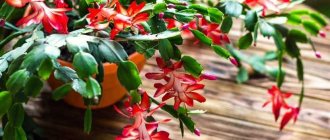Features of the plant type with photo
The ficus is native to India and Indonesia, where the plant grows as an evergreen tree and reaches 30 meters in height. Many varieties of its decorative foliage indoor analogues have been developed. The rubber-bearing ficus is also called elastica, and it received the prefix “rubber-bearing” for the presence in its juice of a substance from which rubber can be made. Belongs to the Tutov family.
Characteristic features of elastic:
- dense oval-shaped leaves with pointed tips;
- The color of the leaves can be dark green, burgundy, and also with light splashes;
- the stem is strong, in adult plants it is tree-like;
- has milky juice with a high isoprene content;
- the tree is capable of flowering, but produces flowers quite rarely;
- elastica rarely produces side shoots without outside help;
- prefers an average temperature of 16-18 degrees;
- reproduces in several ways.
Several varieties of this species have been bred, which differ in appearance and care characteristics:
- Melanie;
Melanie - Belize;
Belize - Robusta;
Robusta - Tineke;
Tineke - Black Prince;
Black Prince - Abidjan;
Abidjan - Tricolor;
Tricolor - Sriveriana;
Sriveriana - Variegata.
Variegata
The houseplant is easy to care for and does not require additional expensive fertilizers. The tree grows quickly and has a long lifespan.
You may be interested in:
How to care for geraniums in winter? Many women love to grow flowers at home, because it’s not only beautiful, but there’s something to do with their free time....Read more...
Ficus rubber diseases and pests (treatment)
The tree is relatively resistant to various diseases and is rarely attacked by pests. But sometimes scale insects and spider mites cause harm to the green beauty. To combat them, tobacco infusion is suitable. Four large spoons of powder are stirred in a liter of water and a little grated laundry soap is added. The mixture is applied to the leaves. After two hours, the solution is washed off.
If affected by scale insects, manually remove all insects from the foliage. To do this, use a cloth soaked in a solution of laundry soap. It is important not to spill it on the ground, so as not to destroy the flower. The tree is left to dry in a warm place. Then the foliage is sprinkled with tobacco dust. The main signs of a pest are a sticky coating and a distinct smell of rot.
If the top of the leaves are covered with a specific silvery coating, and characteristic reddish bumps appear on the reverse side, this is a thrips attack. In this case, careful treatment of the bush with Aktara will be required. Take 4 grams of the drug per 5 liters of water and spray the plant. The soil is subsequently watered with the same solution once every five days.
Fungal diseases can cause yellowing of leaves. The Cercospora fungus appears in the form of black spots, then yellowing of the leaf occurs, accompanied by a process of wilting and falling. Various fungicides are used as treatment. They treat the bush and inspect neighboring specimens. They are also at risk.
Attention! Keeping the leaves clean is the key to your pet's health.
Yellow spots mixed with a hint of rust indicate the presence of another fungal disease - botrytis. The spots grow and the ficus dies. Remove the affected shoots and treat the green pet with a fungicide solution.
Preparing cuttings for propagation, rooting
The simplest and most popular way to propagate elastica is to use cuttings. It is best to carry out the procedure between March and June. In order for the transplantation process to be successful, you should choose adult ficuses that already have lignified shoots. The algorithm for preparing cuttings is as follows:
- You need to cut a cutting 10-15 cm long at an angle. Both the top of the plant and the side shoot are suitable for this purpose.
Ficus cuttings - The cut must be thoroughly washed under running water or soaked for a couple of hours in warm water until the milky juice, which forms a plug on the cut, completely disappears.
- Make several vertical cuts at the bottom of the branch and tear off the lower leaves. Only after this can you move on to rooting it.
- The first option is rooting in water. You need to place the shoot prepared in this way in water and wait for the roots to appear. To speed up the procedure, you can use special biostimulants or activated carbon.
Advice!
It takes 3-4 weeks for the flower to take root. Creating a greenhouse effect will help speed up the process of root emergence. Simply place a plastic bag or plastic bottle over the branch. You should not forget to add water to the container during the process of germination of the cuttings.
Germination of cuttings
The first sign of the appearance of roots will be the formation of white nodules in the area of the cut, which will soon turn into roots. The next step in obtaining a new young ficus will be planting sprouted branches with young roots in the soil.
Step-by-step instructions for working with cuttings
- Prepare a sharp knife, napkins, a jar of settled water, activated carbon, and hair bands.
- Cut the intended cutting at an angle to the mother plant.
- Pluck out the lower leaves. The upper ones are large - wrap them in a tube and secure with rubber bands. If the leaves are small, there is no need to curl them.
- Cover the wounds on the mother plant with a napkin to absorb the flowing juice.
- Place the cuttings on napkins so as not to stain the surface on which the cutting is performed.
- After the juice stops flowing from the cutting, lubricate the tip of the stem with a growth stimulant and place the plant in a jar with water that does not reach a couple of centimeters to the remaining leaves. Every 10 days, change the water by adding an activated carbon tablet to it.
Planting cuttings
To plant a prepared cutting, you will need a mixture of substrate and a container, which does not have to be large, since after the start of the active growth phase it will be possible to transplant the elastica into a more suitable pot.
It is necessary to prepare the following substrate for the successful development of a young plant:
- peat – 1 part;
- sand – 1 part;
- drainage – 1 part;
- leaf soil - 5 parts.
For sterilization, it is also recommended to water this substrate with a solution of potassium permanganate and, after drying, begin planting the plant. The procedure for planting cuttings is standard; you need to make a hole and moisten the soil, loosen it and then place the sprout in the hole made, keeping as close to the center as possible.
Rooted cuttings
Water method
There are several ways to root a ficus. Rooting cuttings in water is the easiest of them. The prepared branches must be placed in boiled water so that it covers the lower growing point. It is better to take a container that is darkened, since blue-green algae quickly appears in the sun, preventing root growth.
Once every 3-4 days, the water needs to be refreshed - change about half the volume with a new one, plus top up to the desired level as it evaporates. It is not worth keeping the ficus in water for a long time. As soon as roots of 2-3 cm appear, the plant can be transplanted into the ground. If you allow the root system to develop too much in the water, then later the bush will have a hard time being moved into the ground.
Caring for young ficus trees
A young plant requires special care in the first two months, as during this period it gains strength and becomes a full-fledged independent ficus. It is important to adhere to the following rules when caring for young elastics:
- Choose a place with good lighting but not direct sunlight. This will allow the small ficus to grow and gain strength, maintaining the shape of the leaves and strengthening the stem. If there is too much light, it will stretch upward, and the leaves will not be able to fully bloom and, most likely, will dry out.
Ficus care - Depending on the time of year, you need to maintain the temperature: in winter – 15-18°C, and in summer – 25-28°C.
- Avoid drafts, they are harmful to the developing sprout.
- Proper watering is the key to a beautiful and healthy plant. Young elastic needs to be moistened every 3-5 days, depending on the ambient temperature.
Important!Do not overdo it, so as not to flood it, stick to the watering regime, since dry soil will not allow the young sprout to develop fully. It is also important to wipe the leaves or spray them with a spray bottle.
- Feeding of young ficus in the active growth phase should be introduced from the second week from the day of planting in the soil and should be done every 10-14 days; it will give strength to the roots of the plant and also help the development of new leaves. A universal fertilizer for deciduous plants is suitable for this purpose.
You may be interested in:
Propagation of black currants by cuttings in summer A berry grown with your own hands will be much tastier. With the help of cuttings, a plant can help in 1 year...Read more...
By adhering to these simple rules, you can grow ficus yourself from cuttings and soon get a new plant that is pleasing to the eye at home.
Ficus rubber at home
Traditionally, from October until the end of winter, the green pet rests - a period of rest begins. But by maintaining the required temperature, additional illumination with phytolamps and maintaining the required air humidity, the indoor beauty continues to grow and develop. This happens more slowly than in the summer months.
Location
A guest from the subtropics prefers to occupy a permanent place in the house. Does not tolerate frequent movements. It is better to immediately determine the green pet for the final position. He feels best near the window. But under no circumstances should drafts be allowed - this has a detrimental effect on the tree.
Lighting
Sunlight is needed in sufficient quantities. But it is better if he is absent-minded. Plants with variegated leaves are more picky about the level of illumination. Species with uniform coloration tolerate light shade more easily.
Attention! If the indoor beauty begins to lengthen the internodes, the growth of the stem slows down, or the leaves begin to fall off, these may be signs of a lack of sunlight. In winter, it is recommended to provide additional lighting using special phytolamps.
Watering
The rubber plant does not tolerate high substrate humidity. In summer, irrigation should be very abundant, but only after the top layer of soil has dried. In winter, watering should be limited. Be sure to pre-settle the water. It should be warm, room temperature.
Top dressing
During the active growing season, the indoor pet is fed twice a month. For this purpose, a special complex fertilizer is used for plants with decorative foliage properties. If rubber plants are grown using hydroponics, fertilizing is carried out constantly throughout the year. A particularly important component is nitrogen.
Trimming
Carrying out this event allows you to adjust the height of the green pet and give its crown the desired shape. The procedure also allows you to stimulate the growth of foliage in the lower part of the trunk.
It is recommended to start pruning in early spring. It is necessary to prepare a sterile blade and carry out all necessary manipulations with it. The milky juice on the cut should not be washed off.
If you trim the top in order to stimulate the development of side shoots, then this measure will not give the desired result. The green beauty will not branch in different directions. Usually several internodes are trimmed. When the maximum threshold of the desired height is reached, the shoots are shortened again.
Know! If, out of ignorance, the top of the rubber plant was cut off, it can be rooted and planted in a pot with an adult specimen to achieve the visual effect of the bush’s lushness.
Temperature
Since the homeland of this handsome indoor plant is the subtropics, it is very thermophilic. In summer, the temperature range comfortable for its growth ranges from 25 to 30 degrees. In winter, the desired values drop to 16 - 20⁰C. Do not overheat by placing the tub near the radiator of the central heating system. But overcooling on the windowsill is also not permissible. A sudden drop of leaves can be a reaction to cold weather.
Air humidity
It is preferable to maintain a high level of moisture in the surrounding space. To do this, the tree is sprayed every day. Sometimes it is necessary to “bathe” your green pet under the “shower”. Wipe the foliage weekly with a soft damp cloth to remove dust. From time to time, you can specifically polish the leaves using various wax-based products. Non-alcoholic beer, which is absolutely safe for your pet, is also suitable for these purposes.
Substrate
It is important that the soil has a slightly acidic or neutral pH reaction. Young growth prefers light soil. You can make a suitable mixture yourself. To do this, it is enough to take peat, sand and leaf soil in equal proportions. Adult specimens require a higher substrate density. The following homemade soil options have proven themselves well:
- one part each of turf and leaf soil, sand, and peat;
- sand and both types of earth in a ratio of 1:2:2;
- two shares of leaf soil and one each of peat and humus.
Ready-made purchased mixtures from bags intended for growing ficus or palm trees are also suitable.
Important! Do not forget about the formation of a drainage layer. Timely removal of moisture is very important. If desired, the flower can be grown hydroponically.
Possible problems and methods for solving them
The rubber-bearing species is rarely susceptible to disease and is not particularly demanding on living conditions, but still the plant can also suffer if it is not cared for properly or pests appear. Common problems when caring for elastic:
- Incorrect watering, which leads to drying out or, conversely, waterlogging of the elastic. If it dries out, the watering regime should be normalized, and the plant will recover. If it was flooded and the roots began to rot, then you can try to save the flower by replanting it in new soil and removing the damaged roots.
- Yellowing of leaves due to excess light or excessive proximity of heating devices to the flower. You just need to move the ficus to another place - and it will regenerate on its own.
Yellowing of leaves - Ficus leaves can also turn yellow due to excess fertilizer; to remove them, it is enough to water the flower generously several times and reduce the dose of the drugs used in the future.
- Elastic develops poorly and takes on an unhealthy appearance if there is an excess of salts in the soil. The problem is solved with the help of a transplant.
Ficus can also suffer from insects; it is advisable to detect their attack on the plant at an early stage and get rid of them. Signs of ficus damage by pests manifest themselves in different ways:
- aphids cover the leaves with sticky clumps;
- as a result of a scale insect attack, brown-white tubercles appear on the leaves;
- spider mites can be noticed by the appearance of a thin cobweb enveloping both the trunk and leaves;
- Mealybugs are characterized by the appearance of fluffy white fibers and sticky liquid on the leaves and stem.
To rid elastic from pests, you need to carefully treat it with special chemicals that are sold in flower shops. You can also use traditional methods of struggle:
- laundry soap;
- toothpaste;
- garlic;
- tobacco;
- nettle;
- calendula;
- elder;
- sagebrush.
You need to prepare an aqueous solution from the above plants and products and thoroughly rinse the ficus with it to get rid of insects. The procedure is effective at the initial stage of infection and requires repetition several times to achieve results.
Ficus rubber transplant
Young animals need to be moved to a different container every year. The most suitable period for holding this event is the spring months and the beginning of summer. Adult trees are replanted as soon as the roots fill the entire volume of the pot. This usually happens every two or three years.
If, when watering, the water quickly leaves the flowerpot, it’s time to replant the green pet. Each subsequent container should be 5 centimeters in diameter larger than the previous one and the same amount deeper than its predecessor.
Important! If the ficus is already old and replanting it is dangerous, it is enough to simply annually change the top three-centimeter layer of substrate in the tub with fresh one.
To move to another container, the bush is taken out along with a lump of earth and transferred to a new container, where a thick drainage layer has already been poured. Empty spaces are carefully filled with fresh substrate. And so on to the very top of the flowerpot.
What kind of pot does a rubber ficus need?
Young animals will feel comfortable in large pots. They can be made of plastic or ceramic. Adult specimens require spacious tubs. Their volume must exceed 10 liters. Following the advice of experienced gardeners will help you choose the optimal container for growing a green pet:
- In terms of shape, a model with equal height and diameter measurements is considered suitable.
- The size of the flowerpot is directly proportional to the dimensions of the root system. There should be at least two centimeters of free space between it and the walls of the pot. If the container is chosen incorrectly and significantly exceeds the required dimensions, the plant may simply rot and die.
- Young animals up to one year old will be comfortable in a flowerpot made of clay without any decorative coating. For older bushes, tubs made of wood, plastic or ceramic are equally suitable.
Attention! The material from which the pot is made must be inert and not react chemically with the soil.
Planting cuttings in the ground
You can plant ficus from cuttings without roots. As a rule, this method is practiced by experienced gardeners. Planting cuttings directly into the ground is more difficult, but the result will be better. The whole process takes place in several stages:
- Prepare planting material.
- Select a pot, add a layer of drainage and soil.
- Plant the cutting, moisten the soil and cover the plant with film.
- Water as needed and ventilate daily.
- As soon as the first green buds form, the film must be removed.
Botanical description and characteristics of the plant
Ficus rubber or ficus elastica (lat. Ficus elastica) is a perennial plant of the Mulberry family.
The thick sap of the plant contains large quantities of rubber, which is a raw material for the production of rubber. Thanks to this, the species received its name. The plant was once cultivated on an industrial scale. The juice helps the ficus “self-medicate”: cuts and wounds quickly heal. In its natural environment, rubber ficus is common in the tropical forests of northeastern India and southern Indonesia. The appearance of a ficus growing in its homeland is significantly different from indoors. Thus, wild ficus is capable of reaching a height of 30-60 meters. As a single-trunk tree grows, it develops branches. Aerial roots form on their surface, which take root when they reach the soil surface. This life form of the plant is called banyan.
Living building material
Local residents nicknamed the ficus rubber snake tree due to its numerous hanging roots and even learned to make bridges across the river from the roots of the plant. The plant lives for about 50 years and then dies.
Bridge made of aerial roots of ficus rubbery photo
When grown indoors, the plant can reach a height of 10 m (the average annual growth is 40-45 cm), but by pruning the ficus is limited in growth. Side shoots practically do not appear. If the rubber ficus reaches the ceiling, the top can be cut off without fear. To prevent a large plant from breaking, it will need support.
Living bridge from ficus photo
Decorative in home cultivation are beautiful leathery leaves with a glossy sheen. They are large (up to 30 cm long, about 15 cm wide), in the shape of an oblong oval with a pointed tip. The leaf plates are attached alternately using thick petioles. The surface of the leaf is smooth and shiny, the color is dark green, the central vein is slightly depressed. The reverse side of the sheet is matte, lighter in color. The color of the leaves of many bred varieties is variegated.
Flowering ficus rubber plant
How ficus elastica blooms photo
At home, rubber ficus blooms extremely rarely, however, the flowers are not particularly decorative. Inflorescence-syconium: has the appearance of a capitate or pear-shaped axis with a hole at the top (it is intended for the penetration of pollinators). Syconium is hollow, with small flowers located on the inner wall. If pollination occurs, fig-like fruits will form. They cannot be eaten.
Precautionary measures
In addition to useful rubber, the plant juice contains toxic substances. Its contact with skin or mucous membranes may cause irritation or a severe allergic reaction. If this happens, thoroughly rinse the affected areas with water and seek medical attention if necessary. Therefore, when working with the plant, it is necessary to wear protective gloves. Also limit access to the plant to children and pets.
It is not recommended to grow rubber ficus at home for people suffering from asthma. Substances released by the plant into the air can cause suffocation.
How fast does Ficus rubber grow?
Ficus elastica can be safely classified as a fast-growing house plant: its growth ranges from 40 to 60 cm per year. In natural conditions, the growth rate is much higher: from 120 to 250 cm. Those who want to get a beautiful ficus tree for interior decoration will really enjoy caring for for such a powerful, responsive plant.
How to care after transplant?
Lighting
This plant loves diffused light, but direct sunlight should be avoided. Experts recommend placing the container with ficus on the eastern or western windowsill. But if this is not possible, then the plant should be placed in the shade, while the bottom of the ficus will quickly shed its foliage, and the growth rate will be moderate.
Temperature
To create the most comfortable temperature regime, you should stick to a temperature of +20 +25 degrees.
In the cold season, the temperature should not fall below +15 degrees, otherwise the plant will die.
Humidity
To humidify the air, spraying is used in warm weather, but in winter it is worth wiping the ficus leaves with a damp sponge. For water procedures, it is recommended to use only settled water at room temperature. It is important to avoid drafts.
Top dressing
To keep the ficus healthy and beautiful, it is worth feeding the plant 2 times a month when it is actively growing. It is necessary to use complex fertilizers in liquid form, and their composition must include nitrogen.
Watering
It is necessary to moisten the soil when it begins to dry out. So, in winter it should be done once a week, in summer - 3 times a week.
If you water the plant too much, it will most likely lose all its foliage.
Propagation by aerial roots
A shoot with aerial roots is the part of the shoot on which root shoots have appeared. This is usually how ampelous plants are propagated. Some of them eject aerial roots themselves after reaching maturity. But most ficus plants need stimulation.
To obtain layering with aerial roots, it is necessary to make two annular cuts at a distance of 0.5 cm from each other. Then in this place you need to remove the bark. The cut is sprinkled with a growth stimulant or activated carbon to prevent infection.
The bare area is wrapped in damp moss, which must be constantly moistened. In a couple of weeks, the first root shoots will appear in this place. After this, the cuttings can be separated and planted in the ground.
The method of cutting and rooting a ficus largely depends on its type. In this case, propagation by apical and lateral shoots is easier, but in this case, part of the planting material necessarily dies. Therefore, it is necessary to initially prepare cuttings with a reserve.
Reproduction by layering with aerial roots is a more effective, but labor-intensive process.
Growing problems:
- Yellowing of the foliage indicates that the plant has been overwatered and the roots have begun to rot. In this case, the ficus needs to be turned out and the condition of the root system checked, damaged roots cut off, and the substrate replaced;
- Growth stops if the ficus lacks nutrients, sunlight or the pot is too small;
- The lower leaves fly away - this is a natural process;
- The plant sheds its leaves due to lack of lighting, exposure to cold drafts, sudden changes in temperature, and too frequent or infrequent watering.
Views: 1,275











